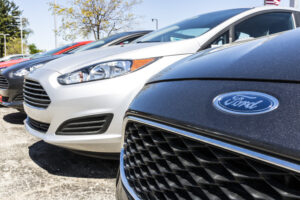
Ford seeking insurance telematics patent to track driver risk
By onInsurance | Technology
Ford Global Technologies is seeking a patent for a built-in insurance management system in each of the OEM’s vehicles that would collect driver behavior data to generate an insurance risk value that would be based “at least in part on the context data and the activation of at least one ADAS feature.”
The patent notes that auto insurance premiums are typically reached based on vehicle purchase price, loss experience, and equipment as well as the driver’s credit score and driving record. And sometimes, driver data “may also include driver provided responses regarding active safety features on the vehicle.”
“However, relying on this data is not substantially accurate and can lead to misinformation,” the patent states. “For example, customers may misinterpret, be unaware, or misrepresent certain vehicle features. The VIN may not provide enough details as to the vehicle equipment or vehicle feature breakdown. Further, using a person’s credit score presents other accuracy and security related concerns, the least of which is that such a metric may not be indicative of a driver’s driving behavior. Such accuracy issues may lead to inaccurate risk and loss predictions, which may in turn lead to insurance pricing that is not commensurate with risk.”
According to the patent, drivers are also “historically reluctant” to install an OBD dongle device in their vehicles that would collect telematics for their insurers so they can receive a good driver discount.
Instead, using data collected from ADAS systems in its vehicles, Ford would calculate risk with a driver score, vehicle score, and context score, which the OEM believes would “provide a more accurate and complete risk analysis for insurance providers.”
The patent also states the risk assessment value could be used by “third party data aggregators.” That drives home the importance, again, for collision repairers to do all they can to protect their customers’ personally identifiable information (PII) as CIECA, Datatouch, CCi Global Technologies, and others have previously described.
 The insurance management system shown in the above diagram could be included on future crossover utility vehicles, SUVs, trucks, RVs, boats, planes, or any “mobile machine” that transports people or goods if the U.S. Patent and Trademark Office approves the patent application. The system would be located in the server or on the vehicle and can be arranged in the cloud or at an insurance provider, according to the patent.
The insurance management system shown in the above diagram could be included on future crossover utility vehicles, SUVs, trucks, RVs, boats, planes, or any “mobile machine” that transports people or goods if the U.S. Patent and Trademark Office approves the patent application. The system would be located in the server or on the vehicle and can be arranged in the cloud or at an insurance provider, according to the patent.
Whether ADAS systems are activated and how often they’re used would be tracked. This includes blind spot detection, adaptive cruise control, backup cameras, collision avoidance systems, forward collision warning, driver alertness detection, and many more. Other data collected to reach a driver’s score would be mileage, speed, the time of day the vehicle is typically driven, location, and more through a dongle, other telematic data, or the driver’s phone.
PII that could be collected includes age, race, ethnicity, gender, marital status, income, credit score, employment, occupation, and more. “This may be data that is provided by the driver at the time of registering the vehicle, purchasing the vehicle, applying for insurance, quotes, etc. This demographic data may be weighed against other statistical data for similarly situated individuals to also be a factor in determining the driver score.”
Collision repair data including costs of repairs, length of repairs, totality rates, and more may also be collected. In addition, each vehicle’s accident history; repair, part, and maintenance costs; make, model, features, warranty claims, and recall information would be gathered to generate each vehicle score.
The context score would be reached by analyzing weather conditions, traffic patterns, intersections driven, and traffic or accident “hot spot” data.
IMAGES
Featured image credit: jetcityimage/iStock
A diagram shows how Ford’s insurance management system could be set up if its patent is approved. (Credit: U.S. Patent and Trademark Office)
